Performance Study of the Vibrating Wire Technique to Determine Longitudinal Magnetic Field Profile Using Scans to High Wire Harmonic
Abstract
1. Introduction
1.1. Overview
1.2. Theory
1.3. Experimental Uncertainty
1.4. Considering Nonlinear Wire Motion
2. Materials and Methods
2.1. Equipment
2.2. Alignment
2.3. Wire Detector Calibration
2.4. Measurements
2.4.1. Precision Study
2.4.2. Field Reconstruction Study
2.4.3. Hall Probe Reference
2.5. Data Handling
2.5.1. Tagging Bad Points
2.5.2. Curve Fitting
3. Results
3.1. Shifted Detector Problem
3.2. Precision Study
3.2.1. Improving Scan Precision
3.2.2. Environmental Correlations
3.2.3. Trends in Horizontal and Vertical Channels
3.3. Field Reconstruction Study
3.3.1. Typical Frequency Response Scans
3.3.2. Distortion of the Typical Frequency Response
3.3.3. Curve Fitting Coefficients
3.3.4. Wire Length and Sensor Position
3.3.5. Field Reconstruction and Hall Probe Comparison
4. Discussion
Possible Future Work
Funding
Data Availability Statement
Acknowledgments
Conflicts of Interest
Abbreviations
| Arb. | Arbitrary unit |
| CLS | Canadian Light Source |
| CSV | Comma separated values |
| CV | Coefficient of variation |
| DST | Discrete Sine transform |
| ESRF | European Synchrotron Radiation Facility |
| HP | Hall probe |
| NMR | Nuclear magnetic resonance |
| PW | Pulsed wire |
| RC | Rotating coil |
| RMS | Root mean square |
| SDEV | Standard deviation |
| SSW | Single stretched wire |
| VW | Vibrating wire |
Appendix A
Appendix B

References
- Le Bec, G. Permanent Magnets. In CERN Accelerator School Course on Normal- and Superconducting Magnets; CERN: Pölten, Austria, 2023; Available online: https://indi.to/KCcG7 (accessed on 8 July 2025).
- Russenschuck, S. Overview Design of Accelerator Magnets. In CERN Accelerator School Course on Normal- and Superconducting Magnets; CERN: Pölten, Austria, 2023; Available online: https://indi.to/J5YWH (accessed on 24 June 2025).
- Ballarino, A. Technical Superconductors: HTS. In CERN Accelerator School Course on Normal- and Super-conducting Magnets; CERN: Pölten, Austria, 2023; Available online: https://indi.to/FCMN2 (accessed on 8 July 2025).
- Zangrando, D.; Walker, R.P. A Stretched Wire System for Accurate Integrated Magnetic Field Measurements in Insertion Devices. Nucl. Instrum. Methods Phys. Res. Sect. A Accel. Spectrometers Detect. Assoc. Equip. 1996, 376, 275–282. [Google Scholar] [CrossRef]
- Le Bec, G.; Chavanne, J.; Penel, C. Stretched Wire Measurement of Multipole Accelerator Magnets. Phys. Rev. ST Accel. Beams 2012, 15, 022401. [Google Scholar] [CrossRef]
- Davies, W.G. The Theory of the Measurement of Magnetic Multipole Fields with Rotating Coil Magnetometers. Nucl. Instrum. Methods Phys. Res. Sect. A Accel. Spectrometers Detect. Assoc. Equip. 1992, 311, 399–436. [Google Scholar] [CrossRef]
- DiMarco, J. Printed Circuit Board Based Rotating Coils for Measuring Sextupole Magnets. IEEE Trans. Appl. Supercond. 2024, 34, 1–4. [Google Scholar] [CrossRef]
- Kitamura, H.; Seike, T.; Tanaka, T. In-situ Undulator Field Measurement with the SAFALI System. In Proceedings of the 29th International Free Electron Laser Conference, Novosibirsk, Russia, 26–31 August 2007; Budz, P., Goldenberg, B., Eliseev, V., Zhirkova, A., Eds.; JACoW Publishing: Geneva, Switzerland, 2007. [Google Scholar]
- Vannozzi, A. INFN—LNF Magnetic Measurement Laboratory Status and Upgrade. In Proceedings of the 23rd International Magnetic Measurement Workshop, Bad Zurzach, Switzerland, 6–11 October 2024. [Google Scholar]
- Warren, R.W. Limitations on the Use of the Pulsed-Wire Field Measuring Technique. Nucl. Instrum. Methods Phys. Res. Sect. A Accel. Spectrometers Detect. Assoc. Equip. 1988, 272, 257–263. [Google Scholar] [CrossRef]
- Ebbeni, M.; Gehlot, M.; Holz, M.; Tarawneh, H. A Flexible Approach on Pulsed Wire Magnetic Measurement Method. Measurement 2022, 199, 111438. [Google Scholar] [CrossRef]
- Temnykh, A. Vibrating Wire Field-Measuring Technique. Nucl. Instrum. Methods Phys. Res. Sect. A Accel. Spectrometers Detect. Assoc. Equip. 1997, 399, 185–194. [Google Scholar] [CrossRef]
- Wolf, Z. A Vibrating Wire System for Quadrupole Fiducialization. In SLAC Technical Note LCLS-TN-05-11; SLAC National Accelerator Laboratory: Menlo Park, CA, USA, 2005. [Google Scholar]
- Petrone, C. Wire Methods for Measuring Field Harmonics, Gradients and Magnetic Axes in Accelerator Magnets. Ph.D. Dissertation, University of Sannio, Benevento, Italy, 2013. Available online: https://cds.cern.ch/record/1601973 (accessed on 1 May 2024).
- Temnykh, A. The Use of Vibrating Wire Technique for Precise Positioning of CESR Phase III Super-Conducting Quadrupoles at Room Temperature. In Proceedings of the PAC2001—Proceedings of the 2001 Particle Accelerator Conference, Chicago, IL, USA, 18–22 June 2001; Lucas, P., Webber, S., Eds.; IEEE: Piscataway, NJ, USA, 2001; Volume 5, pp. 3469–3471. [Google Scholar] [CrossRef]
- Geraldes, R.; Junqueira Leão, R.; Cernicchiaro, G.; Terenzi Neuenschwander, R.; Citadini, J.F.; Droher Rodrigues, A.R. New Sensor and Non-Contact Geometrical Survey for the Vibrating Wire Technique. Nucl. Instrum. Methods Phys. Res. Sect. A Accel. Spectrometers Detect. Assoc. Equip. 2016, 811, 115–123. [Google Scholar] [CrossRef]
- Fukami, K.; Azumi, N.; Inoue, S.; Kai, T.; Kimura, H.; Kiuchi, J.; Matsui, S.; Takano, S.; Watanabe, T.; Zhang, C. Performance Verification of a Precise Vibrating-Wire Magnet Alignment Technique for next-Generation Light Sources. Rev. Sci. Instrum. 2019, 90, 054703. [Google Scholar] [CrossRef]
- Teotia, V.; Malhotra, S. Single Stretch Wire and Vibrating Wire Measurement System for Characterization of Multipole Accelerator Magnets. J. Inst. 2023, 18, P07029. [Google Scholar] [CrossRef]
- Arpaia, P.; Caiazza, D.; Petrone, C.; Russenschuck, S. Performance of the Stretched- and Vibrating-Wire Techniques and Correction of Background Fields in Locating Quadrupole Magnetic Axes. In Proceedings of the XXI IMEKO World Congress Measurement in Research and Industry, Prague, Czech Republic, 30 August–4 September 2015. [Google Scholar]
- Baribeau, C.; Bertwistle, D.; Ericson, E.; Gilbert, J.; Pedersen, T. Magnetic Measurements of Insertion Devices Using the Vibrating Wire Technique. In Proceedings of the 10th International Particle Accelerator Conference, Melbourne, Australia, 19–24 May 2019; Boland, M., Tanaka, H., Button, D., Dowd, R., Schaa, V.R.W., Tan, E., Eds.; JACoW Publishing: Geneva, Switzerland, 2019. [Google Scholar] [CrossRef]
- Wouters, C.; Calvi, M.; Vrankovic, V.; Sidorov, S.; Sanfilippo, S. Vibrating Wire Technique and Phase Lock Loop for Finding the Magnetic Axis of Quadrupoles. IEEE Trans. Appl. Supercond. 2012, 22, 9001404. [Google Scholar] [CrossRef]
- Temnykh, A.; Levashov, Y.; Wolf, Z. A Study of Undulator Magnets Characterization Using the Vibrating Wire Technique. Nucl. Instrum. Methods Phys. Res. Sect. A Accel. Spectrometers Detect. Assoc. Equip. 2010, 622, 650–656. [Google Scholar] [CrossRef]
- Vasserman, I.; Sasaki, S. Comparison of Different Magnetic Measurement Techniques. In Proceedings of the 13th International Magnetic Measurement Workshop, IMMW13, Stanford, CA, USA, 19–22 May 2003. [Google Scholar]
- Arpaia, P.; Caiazza, D.; Petrone, C.; Russenschuck, S. Challenges in Measuring the Longitudinal Field Profile of a Magnet by a Vibrating Wire. In Proceedings of the 18th International Workshop on ADC Modelling and Testing Research on Electric and Electronic Measurement for the Economic Upturn, Benevento, Italy, 15–17 September 2014. [Google Scholar]
- Narasimha, R. Non-Linear Vibration of an Elastic String. J. Sound Vib. 1968, 8, 134–146. [Google Scholar] [CrossRef]
- Hanson, R.J.; Anderson, J.M.; Macomber, H.K. Measurements of Nonlinear Effects in a Driven Vibrating Wire. J. Acoust. Soc. Am. 1994, 96, 1549–1556. [Google Scholar] [CrossRef]
- Pedersen, H.B.; Knudsen, J.L. Direct Determination of the Non-Linear Connection between Tension and Transverse Amplitude for a Vibrating String. Eur. J. Phys. 2017, 38, 045003. [Google Scholar] [CrossRef]
- Mathematica, version 12.2; Wolfram Research, Inc.: Champaign, IL, USA, 2020.
- Keysight Technologies. 33220A 20 MHz Function/Arbitrary Waveform GeneratorData Sheet. Available online: https://www.keysight.com/zz/en/assets/7018-01144/data-sheets/5988-8544.pdf (accessed on 18 April 2024).
- WaveMetrics, Inc. IGOR Pro Version 6.37 Manual, Vol. III; WaveMetrics, Inc.: Portland, OR, USA, 2015; p. 181. [Google Scholar]
- Smith, D. (Canadian Light Source, Saskatoon, SK, Canada); Höwler, T. (Paul Scherrer Institute, Villigen, Switzerland). Personal communication, site visit, and sharing reference pictures of ESRF wire holders, 2022.
- Levashov, M.; Wolf, Z. Set Up and Test Results for a Vibrating Wire System for Quadrupole Fiducialization. In SLAC Technical Note LCLS-TN-06-14; SLAC National Accelerator Laboratory: Menlo Park, CA, USA, 2006. [Google Scholar]
- Arpaia, P.; Caiazza, D.; Petrone, C.; Russenschuck, S. Uncertainty Analysis of a Vibrating-Wire System for Magnetic Axes Localization. In Proceedings of the 2015 9th International Conference on Sensing Technology (ICST), Auckland, New Zealand, 8–10 December 2015; IEEE: Auckland, New Zealand, 2015; pp. 92–97. [Google Scholar] [CrossRef]

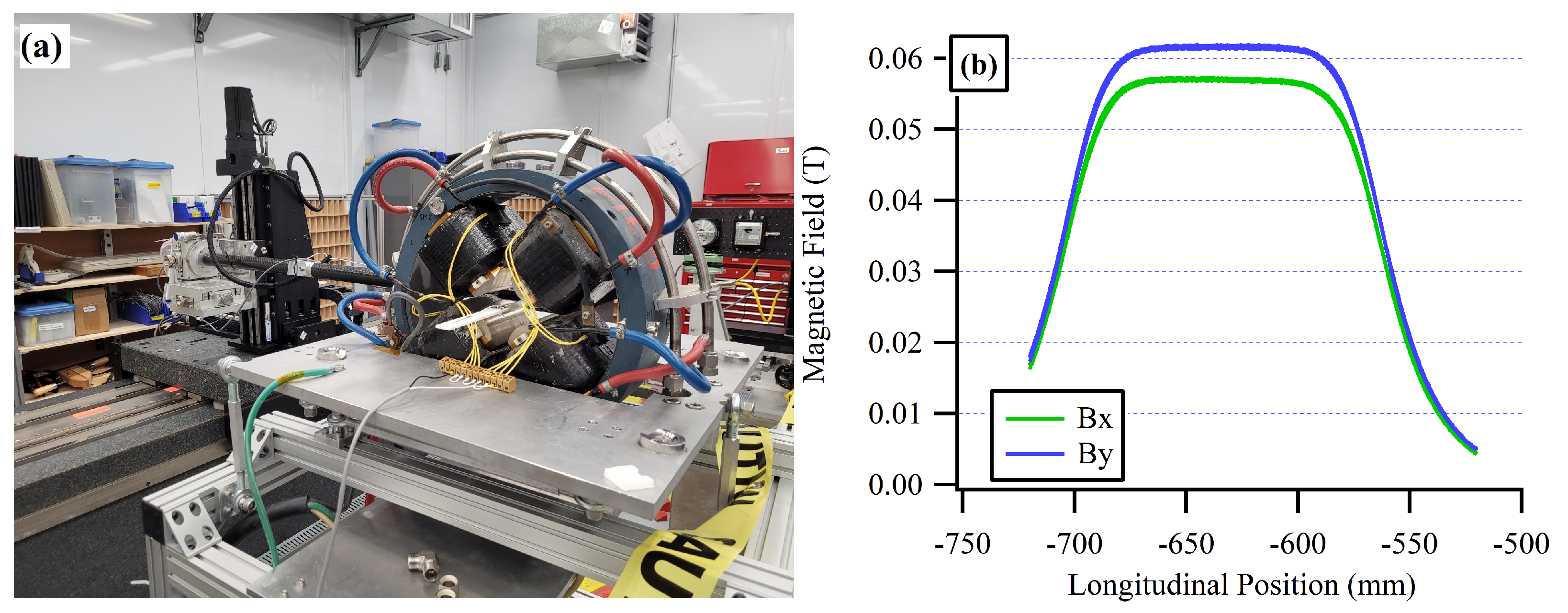
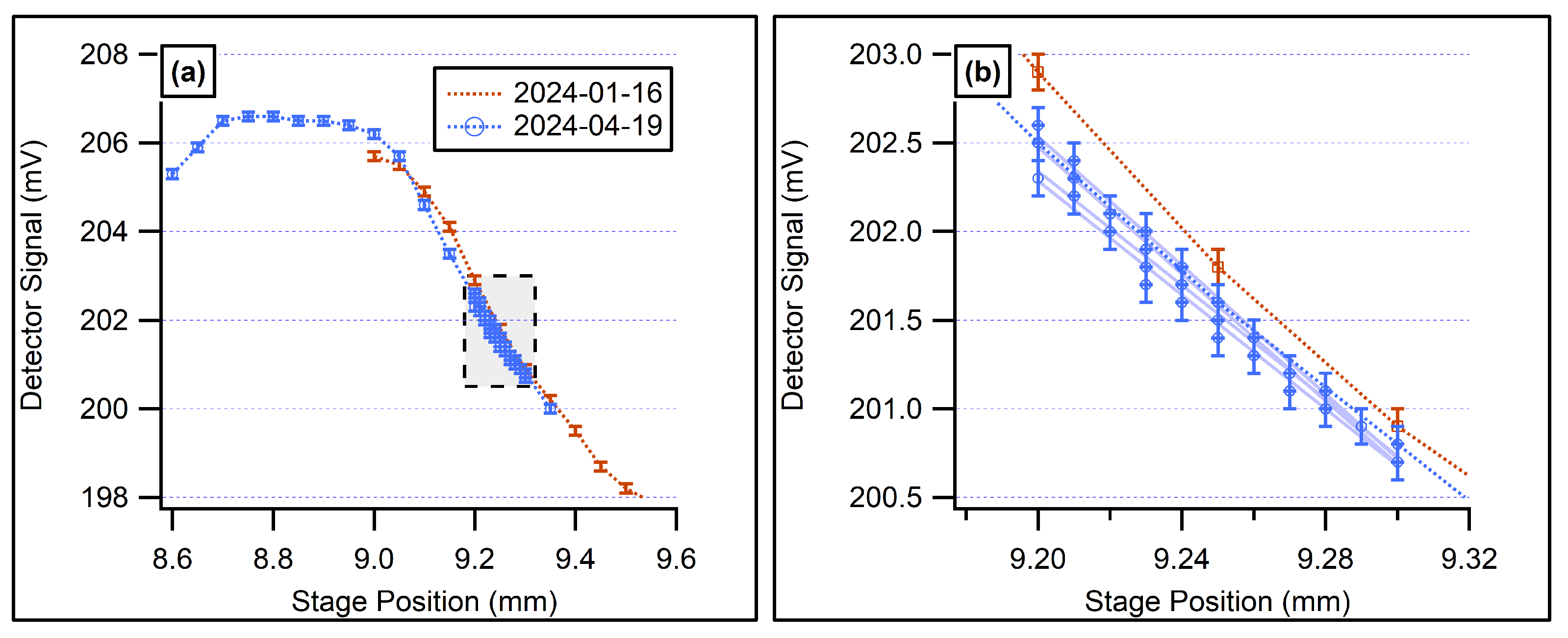
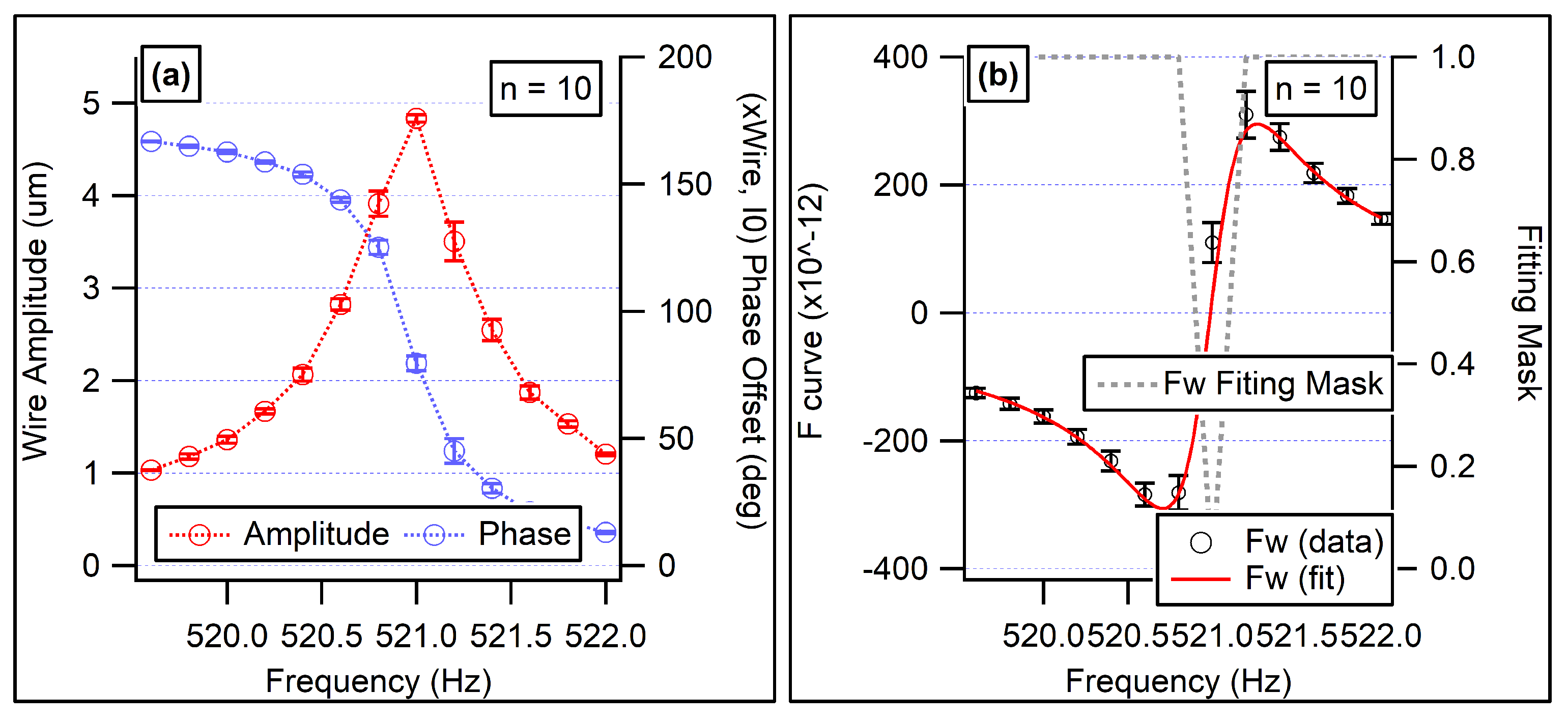
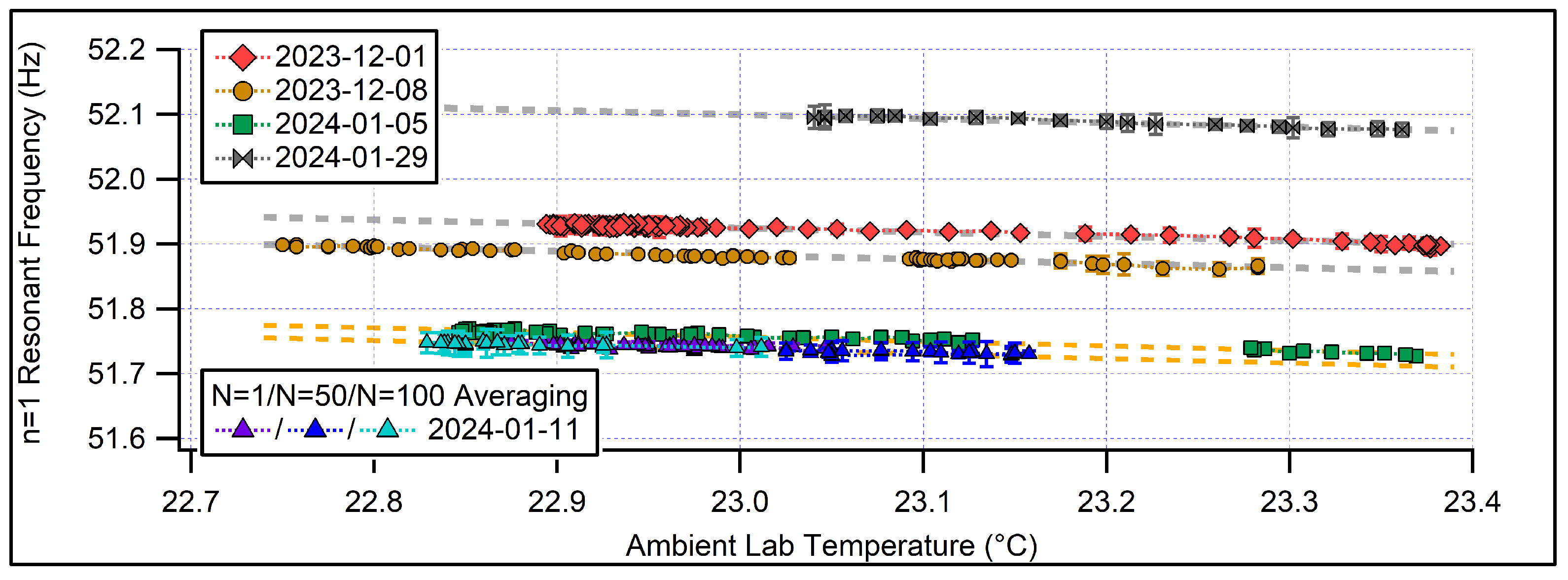
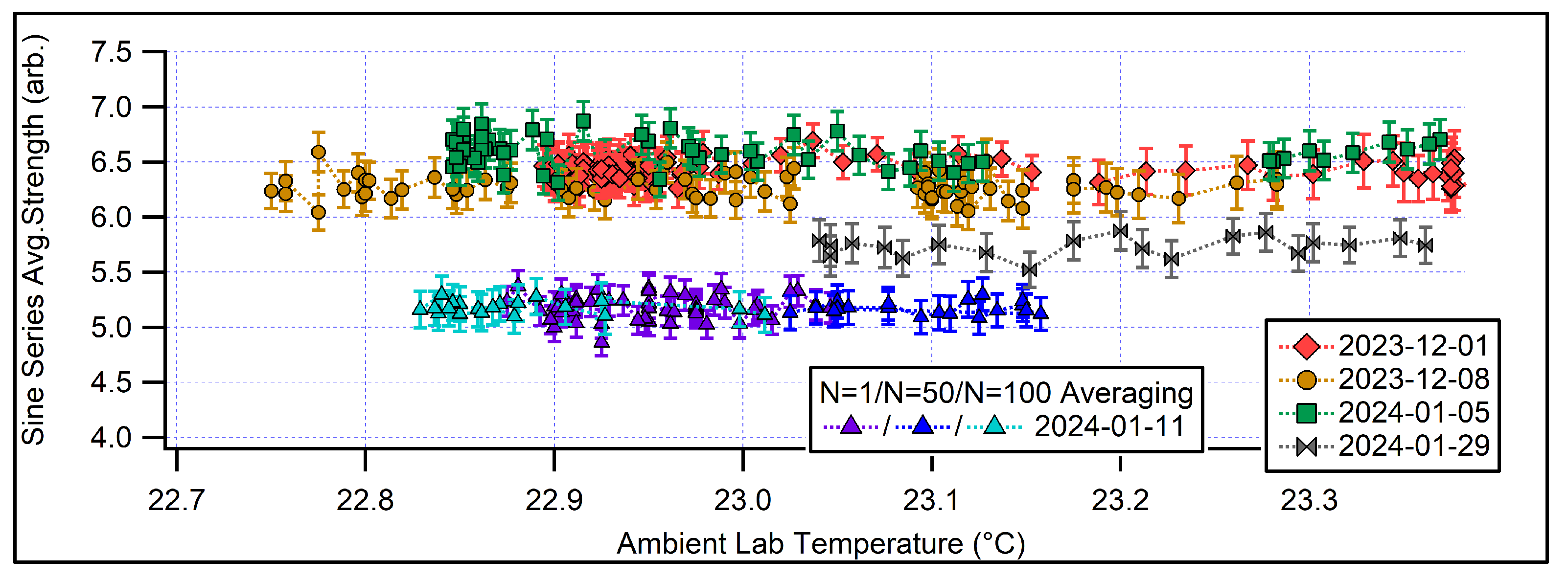
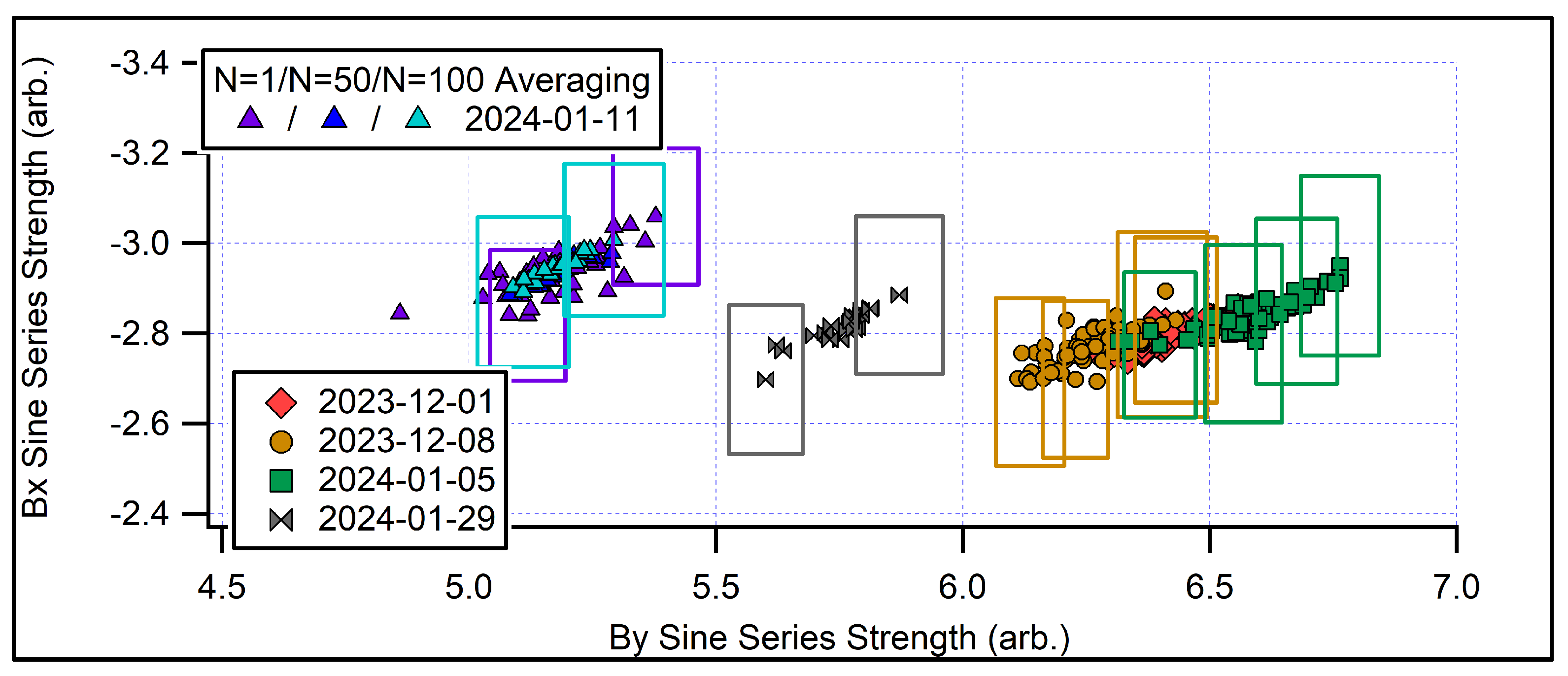
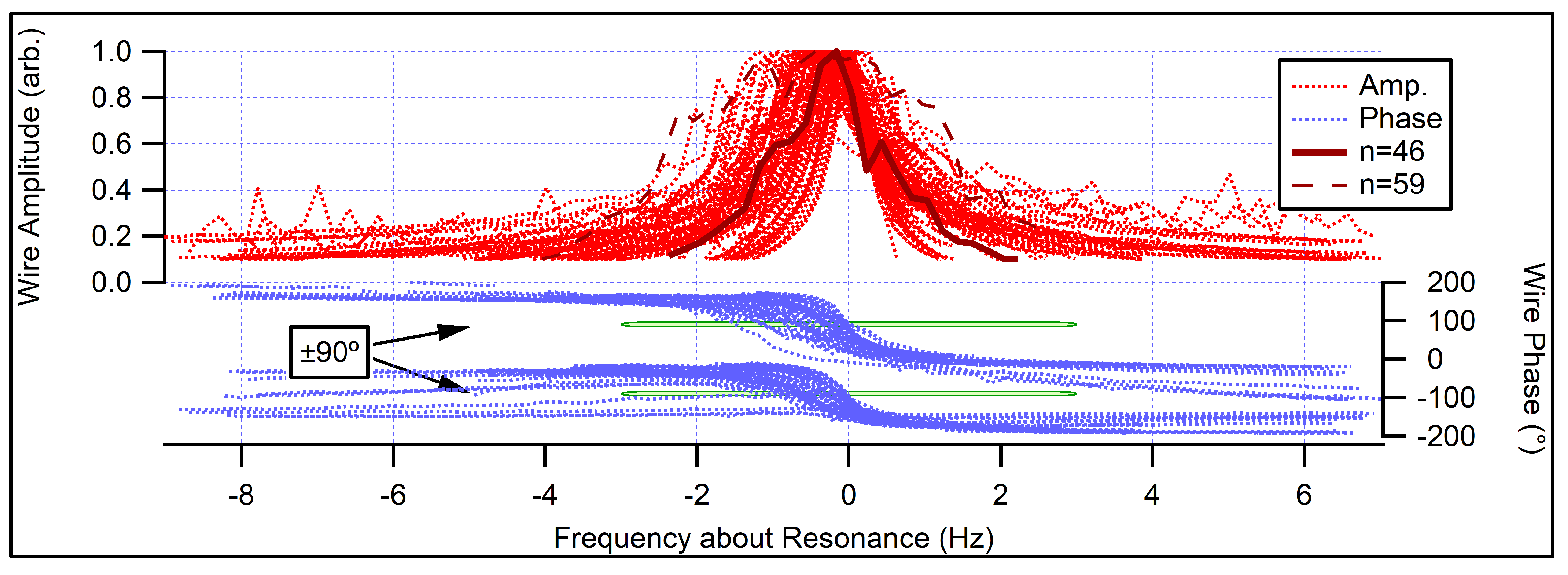
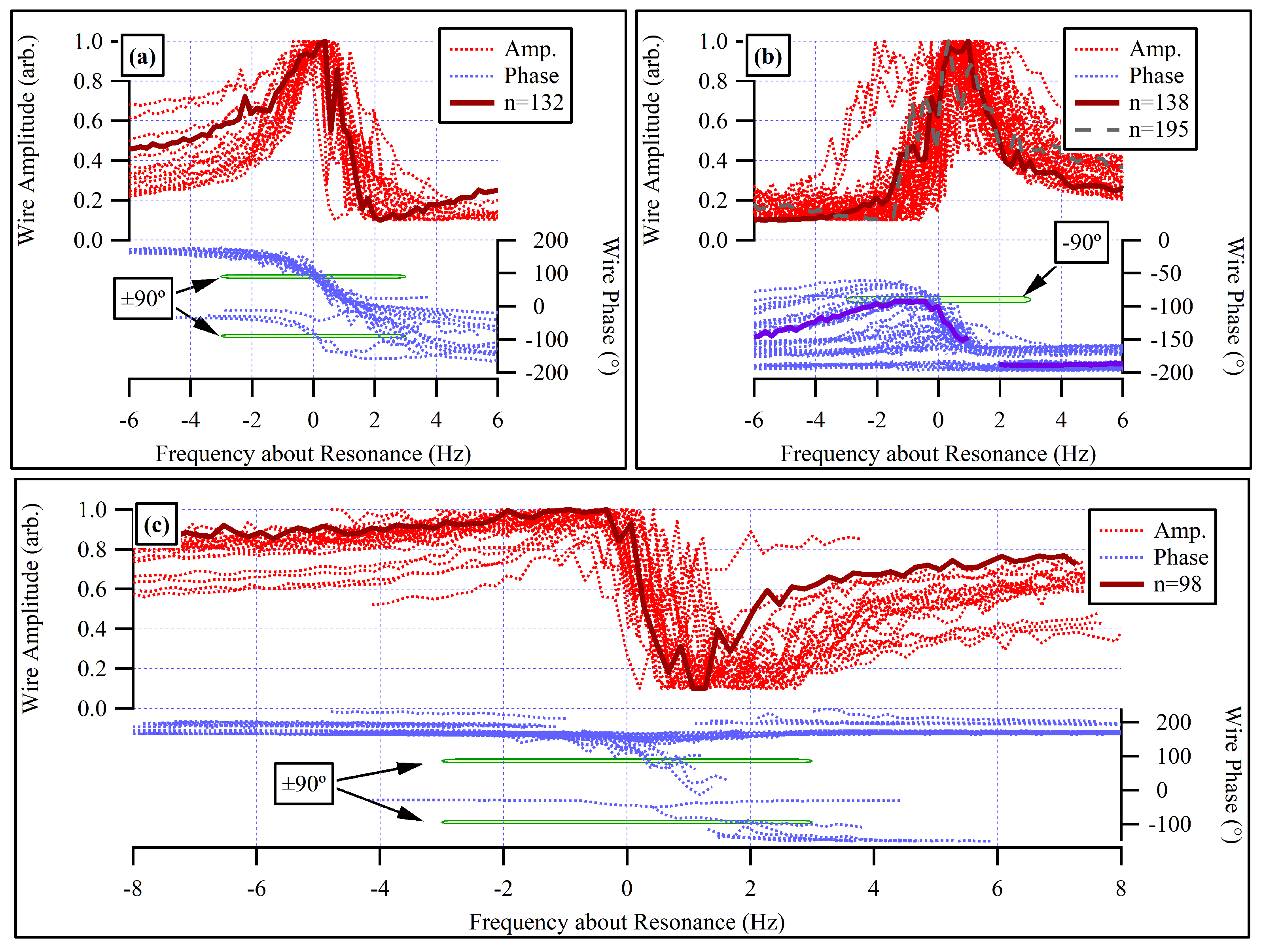

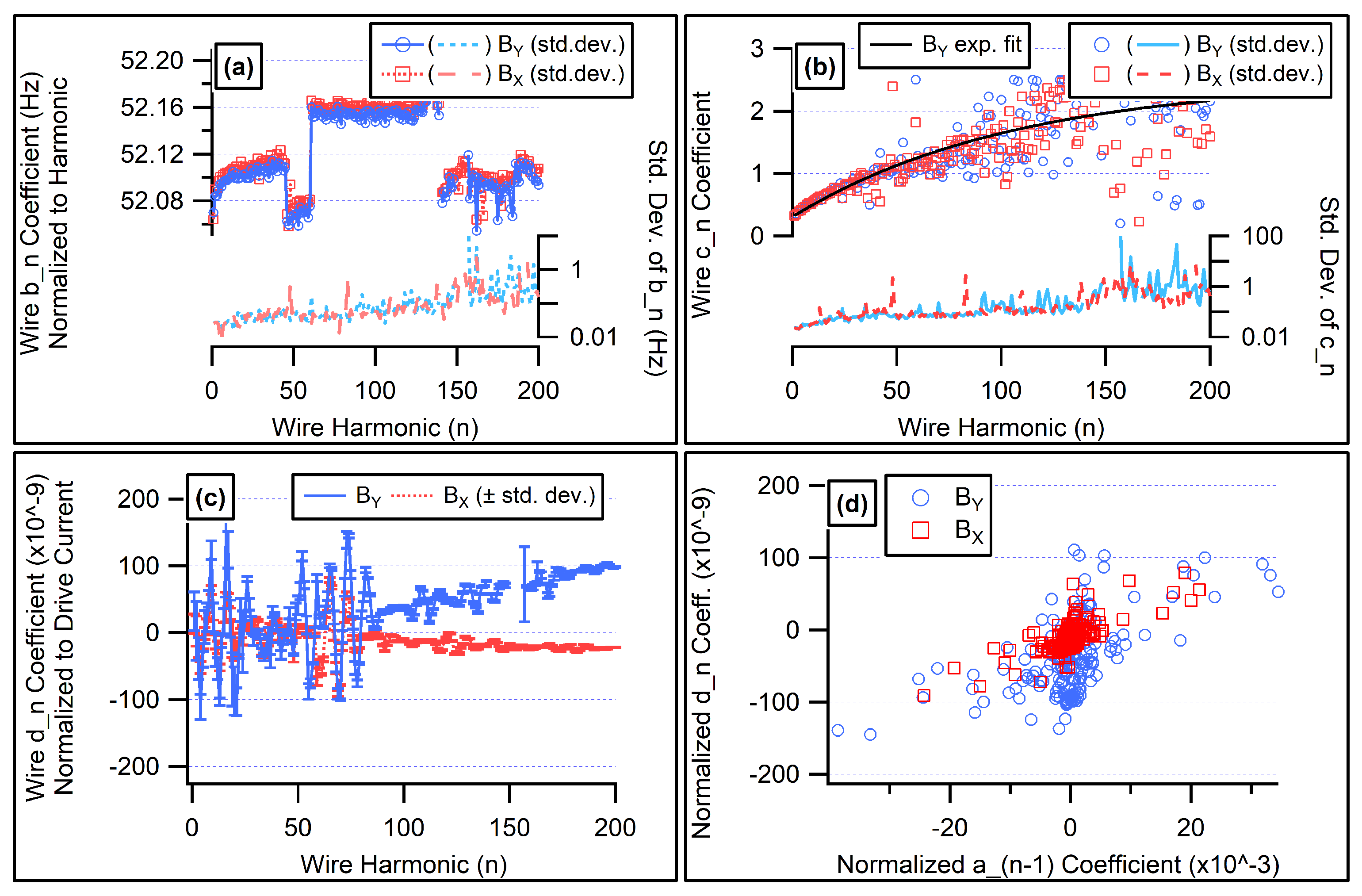
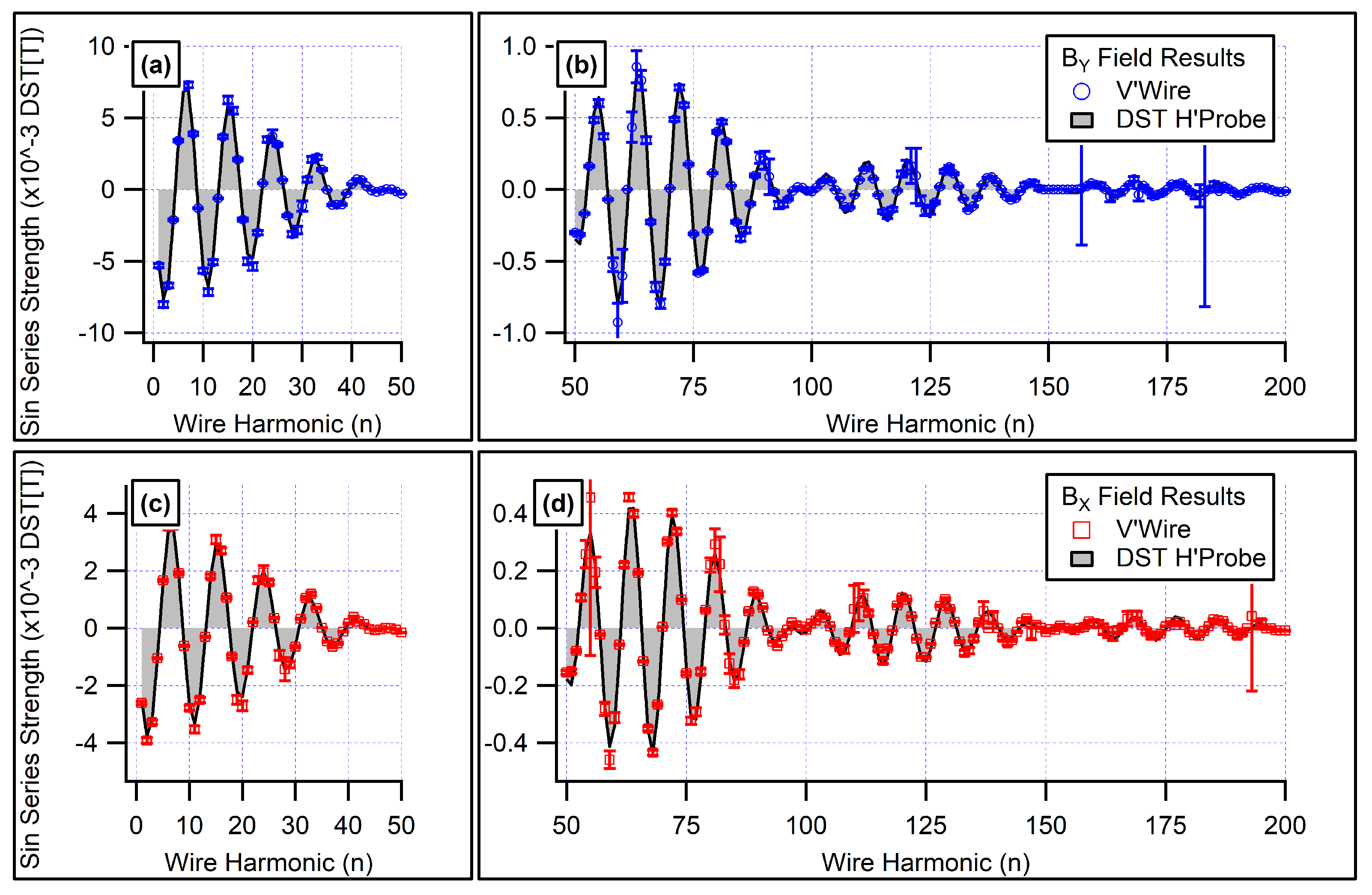


| Scan Parameter | Nominal | Low | High |
|---|---|---|---|
| Frequency step (Hz) | 0.2 | 0.1 | – |
| Wire drive current (pk mA) | 0.25 | 0.15 | 0.5 |
| Settling time (s) (mA) | 4.5 | – | 7 |
| Read delay (s) | 0.1 | – | 0.3 |
| Lock-in sensitivity (µV) | 500 | 200 | – |
| Lock-in time constant (ms) | 100 | – | – |
| Samples averaged/point | 15 | 1 | 100 |
| Measurement | N. Scans | Fit to Full Curve | Masking 90 ± Data | % Drop | ||
|---|---|---|---|---|---|---|
| Date | Mean | SDEV | Mean | SDEV | in SDEV | |
| 1 December 2023 | 100 | 6.42 × | 7.89 × | 6.42 × | 6.58 × | 17 |
| 8 December 2023 | 70 | 6.27 × | 1.04 × | 6.26 × | 7.49 × | 28 |
| 5 January 2024 | 60 | 6.59 × | 1.27 × | 6.59 × | 9.65 × | 24 |
| 11 January 2024 | 90 | 5.18 × | 8.88 × | 5.18 × | 7.62 × | 14 |
| 29 January 2024 | 20 | 5.73 × | 8.67 × | 5.75 × | 6.79 × | 22 |
| N. | Fit to Full Curve | Masking 90 ± Data | ||||
|---|---|---|---|---|---|---|
| Samples | Mean | SDEV | Rel. SDEV | Mean | SDEV | Rel. SDEV |
| 1 | 5.20 × | 9.37 × | 1.00 | 5.21 × | 7.74 × | 1.00 |
| 50 | 5.17 × | 5.46 × | 0.58 | 5.17 × | 6.04 × | 0.78 |
| 100 | 5.18 × | 5.54 × | 0.59 | 5.18 × | 5.24 × | 0.68 |
| Measurement | Mean | SDEV | CV (%) | |||
|---|---|---|---|---|---|---|
| Date | ||||||
| 1 December 2023 | 6.42 × | −2.80 × | 6.58 × | 2.84 × | 1.02 | 1.02 |
| 8 December 2023 | 6.26 × | −2.76 × | 7.49 × | 6.27 × | 1.20 | 2.27 |
| 5 January 2024 | 6.59 × | −2.84 × | 9.65 × | 3.91 × | 1.47 | 1.38 |
| 11 January 2024 | 5.18 × | −2.94 × | 7.62 × | 4.07 × | 1.47 | 1.39 |
| 29 January 2024 | 5.75 × | −2.81 × | 6.79 × | 4.10 × | 1.18 | 1.46 |
Disclaimer/Publisher’s Note: The statements, opinions and data contained in all publications are solely those of the individual author(s) and contributor(s) and not of MDPI and/or the editor(s). MDPI and/or the editor(s) disclaim responsibility for any injury to people or property resulting from any ideas, methods, instructions or products referred to in the content. |
© 2025 by the author. Licensee MDPI, Basel, Switzerland. This article is an open access article distributed under the terms and conditions of the Creative Commons Attribution (CC BY) license (https://creativecommons.org/licenses/by/4.0/).
Share and Cite
Baribeau, C.K. Performance Study of the Vibrating Wire Technique to Determine Longitudinal Magnetic Field Profile Using Scans to High Wire Harmonic. Metrology 2025, 5, 53. https://doi.org/10.3390/metrology5030053
Baribeau CK. Performance Study of the Vibrating Wire Technique to Determine Longitudinal Magnetic Field Profile Using Scans to High Wire Harmonic. Metrology. 2025; 5(3):53. https://doi.org/10.3390/metrology5030053
Chicago/Turabian StyleBaribeau, Cameron Kenneth. 2025. "Performance Study of the Vibrating Wire Technique to Determine Longitudinal Magnetic Field Profile Using Scans to High Wire Harmonic" Metrology 5, no. 3: 53. https://doi.org/10.3390/metrology5030053
APA StyleBaribeau, C. K. (2025). Performance Study of the Vibrating Wire Technique to Determine Longitudinal Magnetic Field Profile Using Scans to High Wire Harmonic. Metrology, 5(3), 53. https://doi.org/10.3390/metrology5030053






